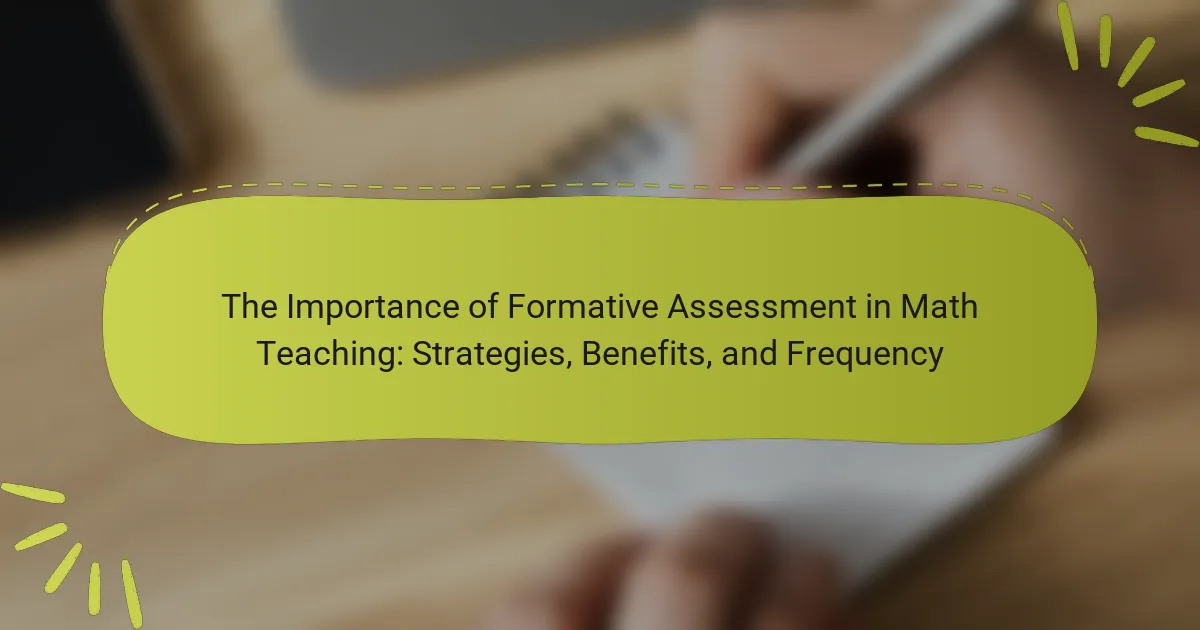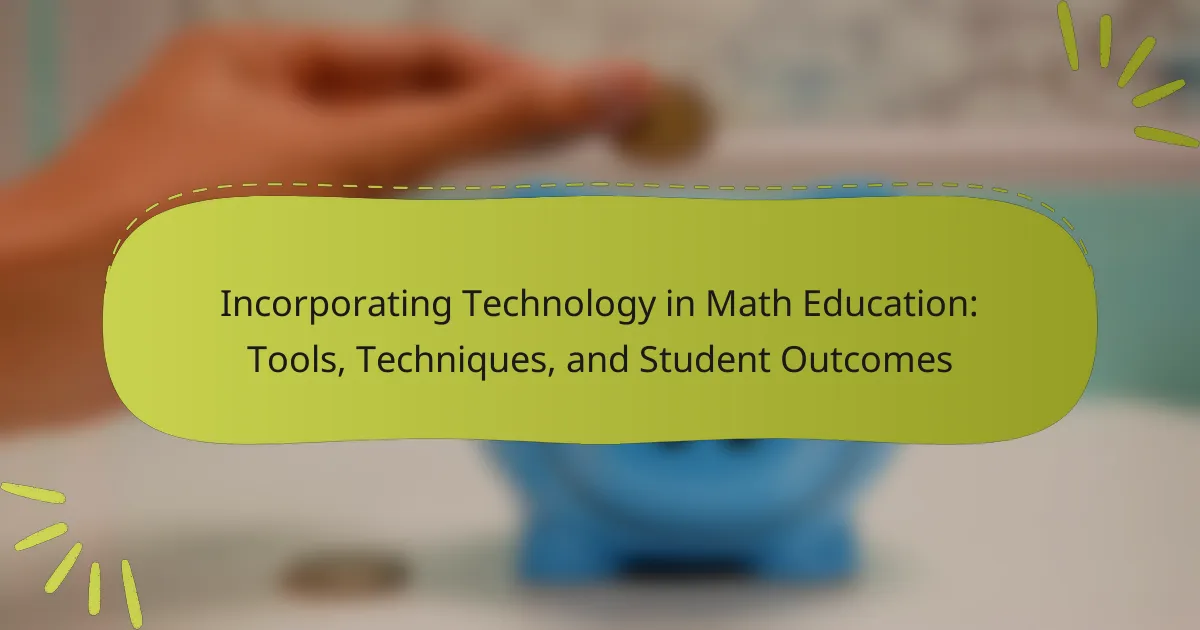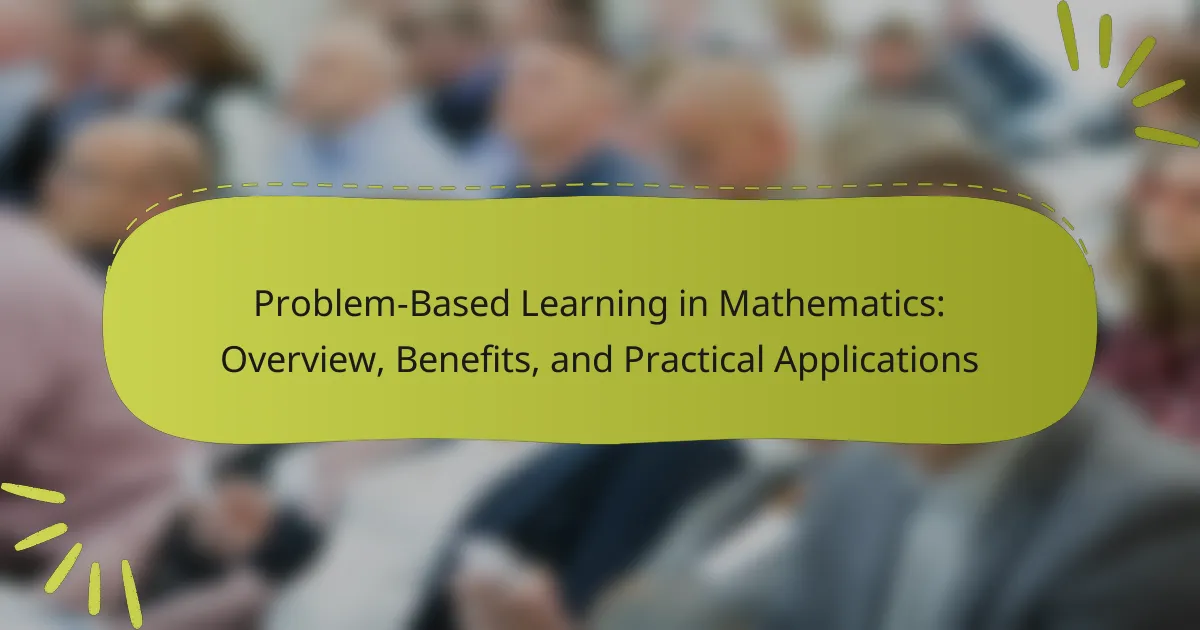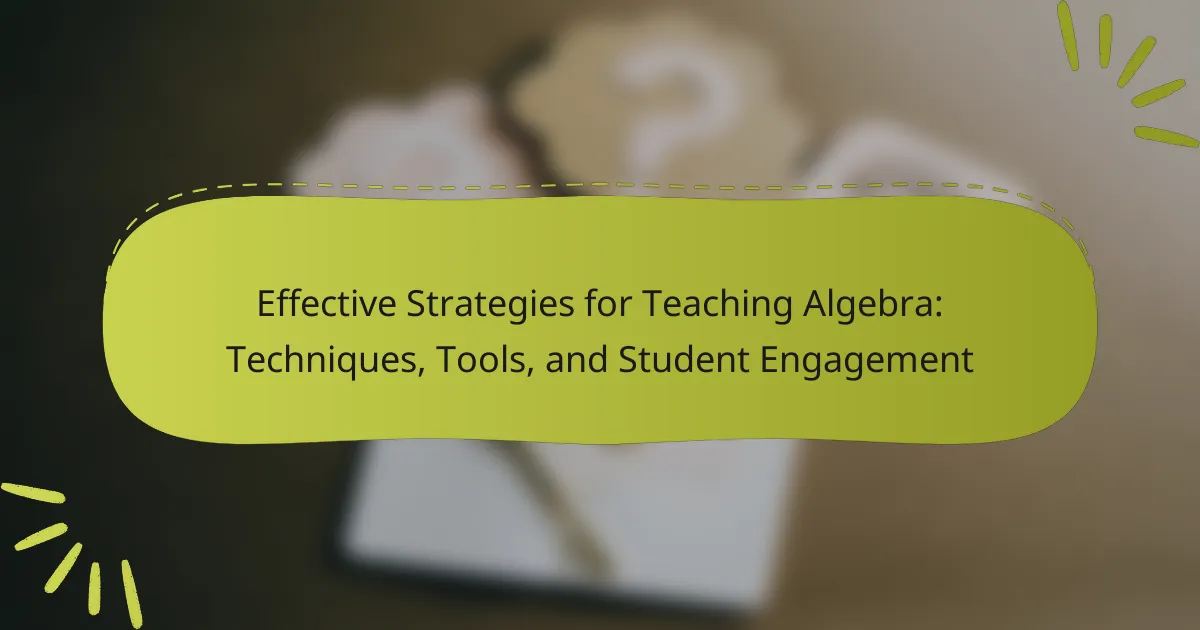Visual aids are essential tools in geometry instruction that enhance student understanding and comprehension of complex geometric concepts. These aids include diagrams, models, and interactive software, which help students visualize relationships between shapes and angles. Research indicates that the use of visual aids significantly improves student performance in geometry assessments, catering to various learning styles and making the subject more accessible. However, teachers face challenges in effectively integrating these visual resources, such as ensuring all students can interpret them, managing the availability of appropriate tools, and balancing their use with the development of independent problem-solving skills. This article explores the benefits, types, and implementation strategies of visual aids in geometry instruction, highlighting their critical role in effective teaching and learning.
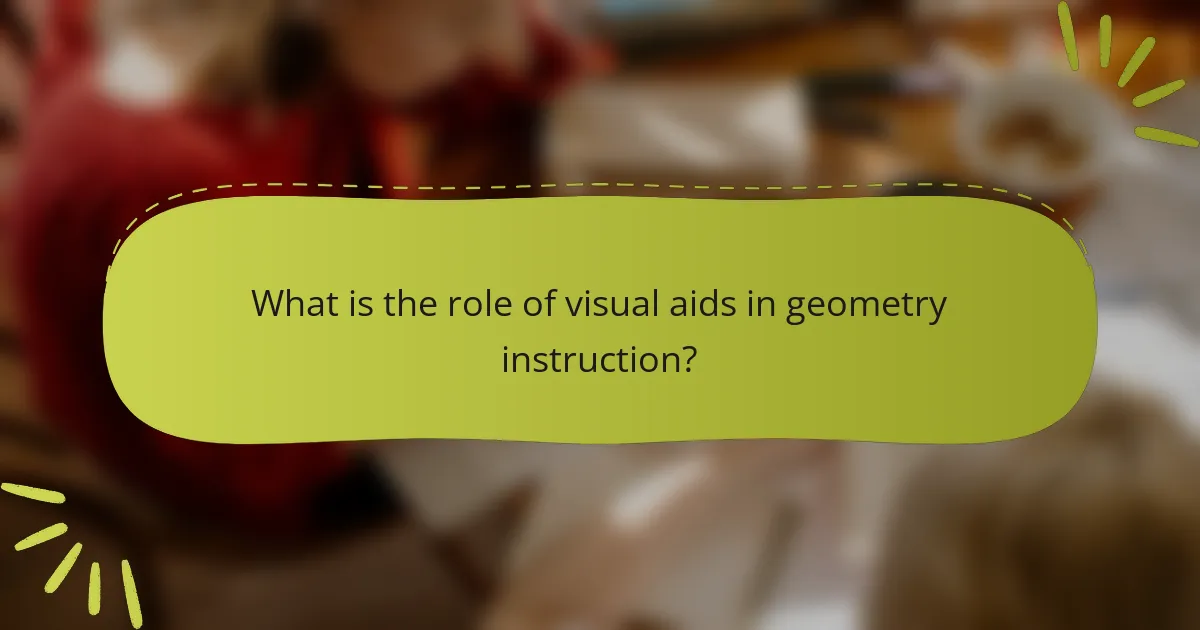
What is the role of visual aids in geometry instruction?
Visual aids play a crucial role in geometry instruction by enhancing student understanding. They facilitate the comprehension of complex geometric concepts. Visual aids include diagrams, models, and interactive tools. These resources help students visualize relationships between shapes and angles. Research indicates that students who use visual aids perform better in geometry assessments. For example, a study by Kershner (2017) found that students using visual tools showed a 25% improvement in problem-solving skills. Furthermore, visual aids cater to various learning styles, making geometry accessible to all students. Overall, they are essential for effective geometry teaching and learning.
How do visual aids enhance the learning experience in geometry?
Visual aids enhance the learning experience in geometry by providing concrete representations of abstract concepts. They help students visualize shapes, angles, and theorems, making them easier to understand. For example, diagrams and models can illustrate geometric relationships that are difficult to grasp through text alone. Research shows that students who engage with visual aids perform better in geometry assessments. A study by Mayer (2005) found that visual representations improve retention and comprehension. This indicates that visual aids not only facilitate learning but also contribute to improved academic performance in geometry.
What types of visual aids are most effective in geometry instruction?
Diagrams and geometric models are the most effective visual aids in geometry instruction. Diagrams help students visualize shapes, angles, and relationships. They provide a clear representation of geometric concepts. Geometric models, such as 3D shapes, offer tactile experiences. These models enhance spatial understanding and engagement. Interactive software and apps also improve learning outcomes. Research shows that visual aids increase retention and comprehension in geometry. A study by Kosslyn et al. (1990) indicates that visual representations boost problem-solving skills.
How do visual aids cater to different learning styles in geometry?
Visual aids cater to different learning styles in geometry by providing diverse methods of information delivery. Visual learners benefit from diagrams and charts that illustrate geometric concepts. Auditory learners can engage with visual aids through accompanying verbal explanations. Kinesthetic learners can interact with physical models or manipulatives that represent geometric shapes. Research indicates that using multiple modalities enhances retention and understanding. A study by Mayer (2001) found that learners perform better when information is presented visually and verbally. This approach addresses various preferences, ensuring a more inclusive learning environment.
What are the key benefits of using visual aids in geometry instruction?
Visual aids in geometry instruction enhance understanding and retention of concepts. They provide concrete representations of abstract ideas. This helps students visualize relationships between shapes and angles. Visual aids also cater to various learning styles, making lessons more inclusive. Research shows that students using visual aids perform better on geometry assessments. For instance, a study by Mayer (2009) found that visual representations improved problem-solving skills. Overall, visual aids foster engagement and motivation in learning geometry.
How do visual aids improve student comprehension in geometry?
Visual aids improve student comprehension in geometry by providing visual representations of abstract concepts. These aids help students visualize shapes, angles, and relationships between geometric figures. Research shows that students using visual aids perform better on geometry assessments. A study by Sweller et al. (2011) found that visual aids reduce cognitive load, allowing for better understanding. Additionally, visual aids cater to different learning styles, enhancing engagement and retention. By illustrating complex ideas, they simplify learning processes and make connections clearer. Overall, visual aids are essential tools in effective geometry instruction.
What impact do visual aids have on student engagement in geometry?
Visual aids significantly enhance student engagement in geometry. They provide concrete representations of abstract concepts. This helps students understand complex shapes and theorems more effectively. Research shows that students using visual aids perform better in geometry tasks. For instance, a study by Mayer (2005) found that visual tools improve retention and comprehension. Engaged students are more likely to participate in discussions. They also demonstrate increased motivation to learn geometry. Overall, visual aids foster a more interactive and stimulating learning environment.
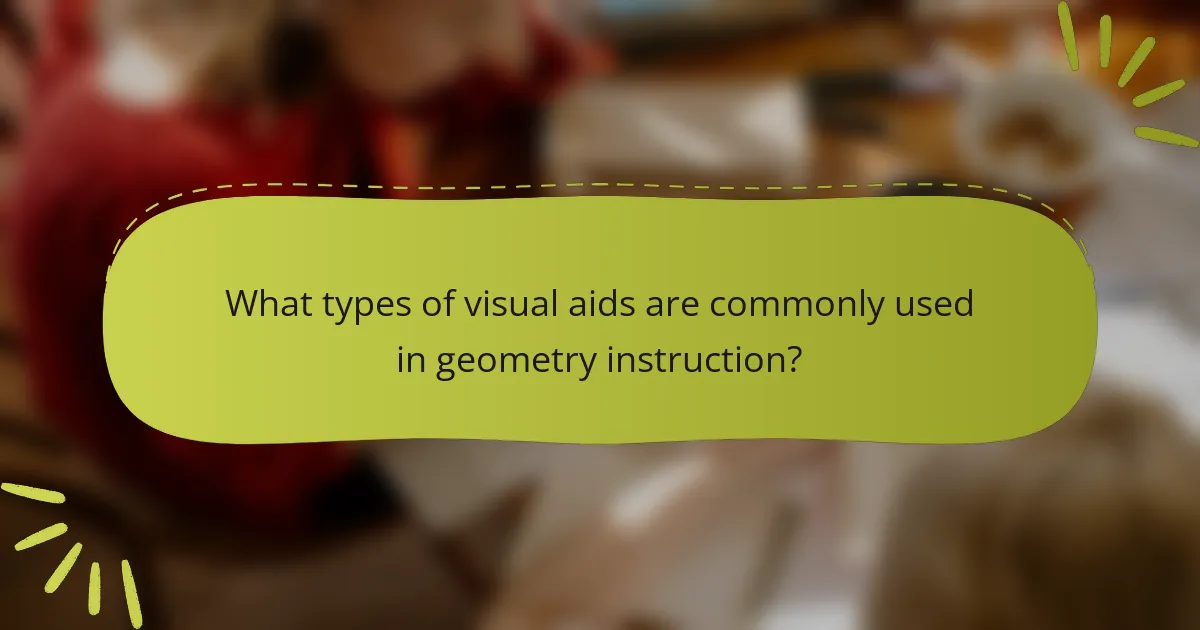
What types of visual aids are commonly used in geometry instruction?
Commonly used visual aids in geometry instruction include diagrams, models, and interactive software. Diagrams illustrate geometric concepts through shapes and angles. Models provide three-dimensional representations of geometric figures. Interactive software engages students with dynamic visualizations. These aids enhance comprehension and retention of geometric principles. Research shows that visual aids improve student understanding and performance in geometry.
What are the differences between static and dynamic visual aids in geometry?
Static visual aids in geometry are fixed representations of geometric concepts. They include diagrams, graphs, and illustrations that do not change. These aids provide a clear and consistent view of shapes and relationships. They are effective for teaching basic properties and definitions.
Dynamic visual aids, on the other hand, are interactive and can change in real-time. They include software applications and animations that allow manipulation of geometric figures. This interactivity helps students explore concepts like transformations and symmetry. Dynamic aids can enhance understanding by providing visual feedback during exploration.
The key difference lies in their interactivity. Static aids remain unchanged, while dynamic aids allow for manipulation and exploration. Research shows that dynamic visual aids can improve student engagement and comprehension in geometry. Studies indicate that students using dynamic aids perform better in problem-solving tasks compared to those using static aids.
How can diagrams and models be utilized effectively in geometry?
Diagrams and models can be utilized effectively in geometry by providing visual representations of geometric concepts. These visual aids help students understand complex shapes and relationships. For example, diagrams can illustrate properties of triangles, such as congruence and similarity. Models can demonstrate three-dimensional figures, aiding in spatial reasoning. Research indicates that visual learning enhances comprehension and retention. A study by Kosslyn et al. (2002) found that students using visual aids performed better in geometry assessments. Effective use of diagrams and models also encourages active engagement in problem-solving. This interaction fosters deeper understanding and application of geometric principles.
What role do technology-based visual aids play in modern geometry education?
Technology-based visual aids enhance modern geometry education by providing interactive and engaging learning experiences. These tools, such as dynamic geometry software and digital simulations, allow students to visualize complex geometric concepts. They facilitate a deeper understanding of spatial relationships and properties of shapes. Research indicates that students using technology-based visual aids perform better in geometry assessments. A study by Clements and Sarama (2009) found that such aids improve conceptual understanding and retention of geometric principles. Additionally, these aids accommodate diverse learning styles, making geometry accessible to a broader range of students. Overall, technology-based visual aids play a crucial role in enriching geometry education.
How can teachers implement visual aids effectively in geometry lessons?
Teachers can implement visual aids effectively in geometry lessons by integrating various types of visual materials. These include diagrams, models, and interactive software. Teachers should align visual aids with specific learning objectives. This ensures that the aids enhance understanding of geometric concepts. For instance, using 3D models can help students grasp spatial relationships. Additionally, incorporating technology, such as geometry software, can provide dynamic visualizations. Research shows that students retain information better when visual aids are used. A study by Mayer (2009) indicates that visuals improve comprehension and retention in mathematics. Therefore, effective implementation of visual aids can significantly enhance geometry instruction.
What strategies can teachers use to integrate visual aids into their curriculum?
Teachers can integrate visual aids into their curriculum by employing several effective strategies. They can use diagrams and charts to illustrate geometric concepts. This method enhances understanding by providing a visual representation of abstract ideas. Teachers can also incorporate multimedia presentations that include videos and animations. Such resources can engage students and make learning more dynamic. Utilizing physical manipulatives, like geometric shapes, allows students to explore concepts hands-on. This tactile experience reinforces learning through active participation. Additionally, teachers can encourage student-created visual aids. This promotes creativity and deeper comprehension of the material. Collaborative group work involving visual projects can further enhance learning outcomes. Research shows that visual aids can improve retention and understanding in subjects like geometry.
How can teachers assess the effectiveness of visual aids in their geometry instruction?
Teachers can assess the effectiveness of visual aids in geometry instruction through student performance and feedback. They should compare test scores before and after implementing visual aids. An increase in scores indicates effectiveness. Additionally, teachers can use surveys to gather student opinions on the aids. Observing student engagement during lessons also provides insight. High levels of participation suggest that the aids are impactful. Teachers can conduct informal assessments, such as quizzes, to evaluate understanding. Analyzing these results helps refine the use of visual aids. Regular reflection on teaching practices is essential for continuous improvement.
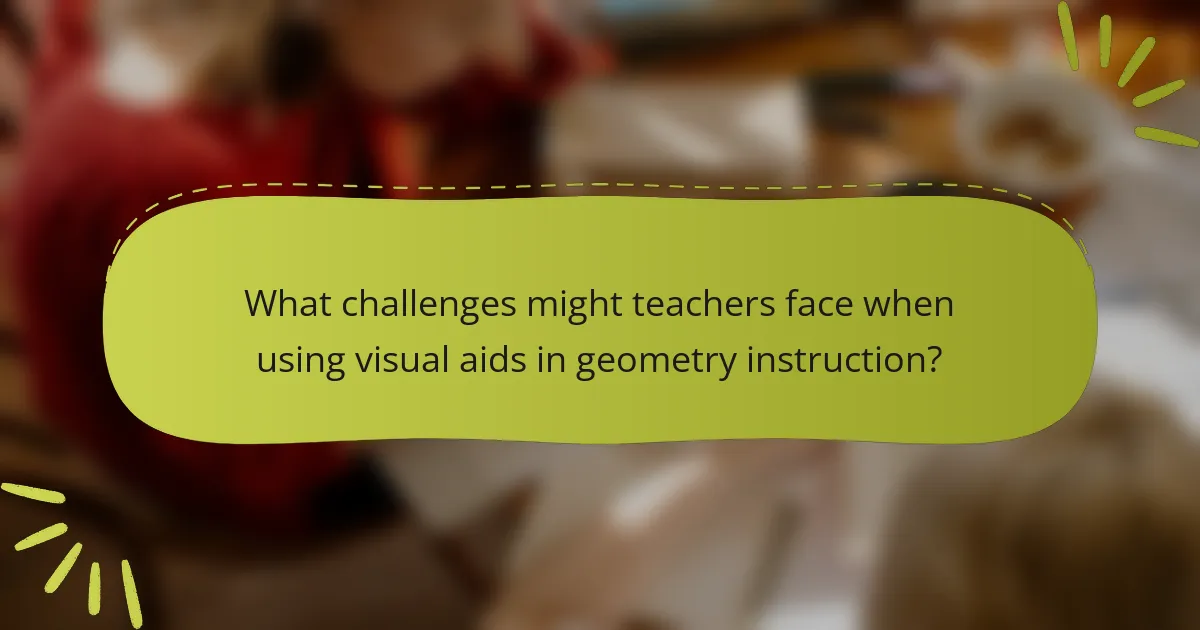
What challenges might teachers face when using visual aids in geometry instruction?
Teachers may face several challenges when using visual aids in geometry instruction. One challenge is ensuring that all students can effectively interpret the visual information. Different students have varying levels of spatial reasoning skills. This can lead to misunderstandings of geometric concepts. Additionally, the complexity of some visual aids may overwhelm students. Teachers must balance detail with clarity to avoid confusion.
Another challenge is the availability and accessibility of appropriate visual aids. Not all classrooms are equipped with technology or materials for effective visual demonstrations. Time constraints can also hinder the preparation of high-quality visual aids. Teachers may struggle to integrate these tools into their lesson plans seamlessly.
Furthermore, some students may become overly reliant on visual aids. This can impede their ability to solve problems independently. Teachers must promote a balance between using visual aids and developing critical thinking skills. Overall, these challenges require careful planning and adaptability from educators.
How can teachers overcome common obstacles to using visual aids?
Teachers can overcome common obstacles to using visual aids by integrating technology effectively. They can utilize digital tools to create engaging presentations. This approach addresses limitations in traditional resources. Teachers should also provide training on visual aid usage. Professional development can enhance their skills. Additionally, they can seek student feedback on visual aids. This feedback can guide improvements. Collaboration with colleagues can also share best practices. Research shows that effective visual aids improve student understanding in geometry (Mayer, 2009).
What resources are available to support teachers in using visual aids?
Teachers can access various resources to support the use of visual aids in instruction. Educational websites offer free downloadable visual aid materials. Platforms like Teachers Pay Teachers provide paid resources created by other educators. Online courses and webinars focus on effective visual aid strategies. Professional organizations, such as the National Council of Teachers of Mathematics, provide guidelines and resources. Additionally, social media groups and forums allow teachers to share visual aid ideas and resources. Research shows that using visual aids enhances student understanding and retention of geometric concepts.
What are some best practices for utilizing visual aids in geometry instruction?
Utilizing visual aids in geometry instruction enhances understanding and retention. Best practices include using clear and labeled diagrams to illustrate concepts. Incorporating interactive tools, such as geometry software, engages students actively. Utilizing color coding can help differentiate between shapes and angles. Providing real-world examples makes abstract concepts relatable. Encouraging collaboration through group activities fosters discussion and deeper understanding. Regularly assessing student comprehension ensures that visual aids are effective. These practices align with educational research supporting visual learning strategies.
How can teachers tailor visual aids to meet diverse classroom needs?
Teachers can tailor visual aids to meet diverse classroom needs by assessing individual learning styles. They should identify whether students are visual, auditory, or kinesthetic learners. Visual aids can include diagrams, charts, and interactive models. Teachers can modify these aids by using color coding for clarity. They can also incorporate technology, such as interactive whiteboards. Adapting visual aids to include real-world examples enhances relevance. Providing multiple formats ensures accessibility for all students. Research shows that differentiated instruction improves student engagement and understanding.
What are the most common mistakes to avoid when using visual aids in geometry?
Common mistakes to avoid when using visual aids in geometry include overcrowding visuals with too much information. This can confuse students and hinder understanding. Another mistake is using visuals that are not aligned with the lesson objectives. Misalignment can lead to misconceptions about geometric concepts. Additionally, neglecting to explain the visuals can leave students without context. Failing to engage students with the visuals can also diminish their effectiveness. Lastly, using outdated or inaccurate visuals can misinform students. Accurate and current representations are crucial for effective learning.
The main entity of the article is visual aids in geometry instruction. The article examines the critical role visual aids play in enhancing student understanding of geometric concepts, highlighting their effectiveness in improving comprehension, retention, and academic performance. It categorizes various types of visual aids, including diagrams, models, and technology-based tools, and discusses their benefits in catering to different learning styles. Additionally, the article outlines strategies for effective implementation and assessment of visual aids, while addressing potential challenges teachers may face in the classroom. Overall, it emphasizes the importance of visual aids in creating an engaging and inclusive learning environment for geometry education.
